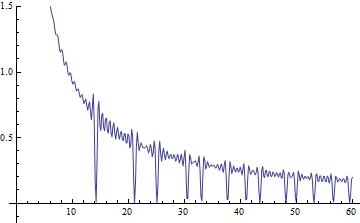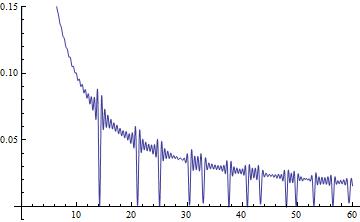Mathematica knows that:
$$\log(n) = \lim\limits_{s \rightarrow 1} \zeta(s)\left(1 - \frac{1}{n^{(s - 1)}}\right)$$
The von Mangoldt function should then be:
$$\Lambda(n)=\lim\limits_{s \rightarrow 1} \zeta(s)\sum\limits_{d|n} \frac{\mu(d)}{d^{(s-1)}}$$
The question is if the following Riemann zeta function product (Spectral Riemann zeta) is equal to the Fourier transform of the von Mangoldt function?
$$\text{Fourier Transform of } \Lambda(n) \sim \sum\limits_{n=1}^{n=k} \frac{1}{n} \zeta(1/2+i \cdot t)\sum\limits_{d|n} \frac{\mu(d)}{d^{(1/2+i \cdot t-1)}}$$
In the case of the logarithm of $2$, log(2), this is equal to a table (red and green) called $\zeta(s)$:
$k \mid n : 1$ else $0$.
matrix multiplied by a second table (red, green and yellow) called $(1 - 2^{1-s})$:
$n=k: 1$ else if $n=2 \cdot k: -2$ else $0$
Picture of tables $\zeta(s)$ and $(1 - 2^{1-s})$ [Image 1]:

Taking the matrix product of the two tables above we get [Image 2]:

The first column then has the numerators of the alternating series.
This is as said:
$$\log(2) = \lim\limits_{s \rightarrow 1} \zeta(s)\left(1 - 2^{(1 - s)}\right)$$
which with a sign change in the exponent is equal to:
$$\log(2) = \lim\limits_{s \rightarrow 1} \zeta(s)\left(1 - \frac{1}{2^{(s - 1)}}\right)$$
Before I get to the actual question I show the Dirichlet series for logarithm of n.
We had already:
$$1-\frac{1}{2}+\frac{1}{3}-\frac{1}{4}+\frac{1}{5}... =\log(2)$$
which is the second column in:
Logarithms of $n$:
$$T_1 = \begin{bmatrix} 0&0&0&0&0&0&0 \\ 1&-1&1&-1&1&-1&1 \\ 1&1&-2&1&1&-2&1 \\ 1&1&1&-3&1&1&1 \\ 1&1&1&1&-4&1&1 \\ 1&1&1&1&1&-5&1 \\ 1&1&1&1&1&1&-6 \end{bmatrix}$$
It turns out that:
$$1+\frac{1}{2}-\frac{2}{3}+\frac{1}{4}+\frac{1}{5}-\frac{2}{6}... =\log(3)$$
and:
$$\displaystyle \log(n)=\sum\limits_{k=1}^{\infty}\frac{T(n,k)}{k}$$
in general. That is same as the Mathematica known formula above.
The recurrence describing matrix $T_1$ is:
$$\displaystyle T_1(1,n)=0; n>1: T(n,k) = \sum\limits_{i=1}^{n-1} T(n,k-i)$$
It is natural to ask what this recurrence might do when applying it symmetrically, like this:
$$\displaystyle T_2(n,1)=1, T_2(1,k)=1, n>=k: -\sum\limits_{i=1}^{k-1} T_2(n-i,k), n<k: -\sum\limits_{i=1}^{n-1} T_2(k-i,n)$$
von Mangoldt function matrix:
$$\displaystyle T_2 = \begin{bmatrix} +1&+1&+1&+1&+1&+1&+1&\cdots \\ +1&-1&+1&-1&+1&-1&+1 \\ +1&+1&-2&+1&+1&-2&+1 \\ +1&-1&+1&-1&+1&-1&+1 \\ +1&+1&+1&+1&-4&+1&+1 \\ +1&-1&-2&-1&+1&+2&+1 \\ +1&+1&+1&+1&+1&+1&-6 \\ \vdots&&&&&&&\ddots \end{bmatrix} $$
Here we then have $\log(2)$ in the second column and second row. Like wise $\log(3)$ in third row and third column.
By doing a Möbius inversion on each row or column one can conjecture that the von Mangoldt function is found as:
$$\Lambda(n)=\lim\limits_{s \rightarrow 1} \zeta(s)\sum\limits_{d|n} \frac{\mu(d)}{d^{(s-1)}}$$
Alteratively by inspecting the numbers in the decimal digits one also finds conjecturally that:
$$\Lambda(k)=\sum\limits_{n=1}^{\infty} \frac{T_2(n,k)}{n}$$
Also, matrix $T_2$ is a matrix with the Greatest Common Divisor as lookup index:
$$T_2(n,k) = a(GCD(n,k))$$
where conjecturally:
$$a(n) = \lim\limits_{s \rightarrow 1} \zeta(s)\sum\limits_{d|n} \mu(d)(e^{d})^{(s-1)}$$
which is also known as the Dirichlet inverse of the Euler Totient starting:
$$1,-1,-2,-1,-4,+2,-6,...$$
And as a side note we can by a result of Wolfgang Schramm calculate the Möbius function from this matrix as:
$$\displaystyle \mu(n) = \frac{1}{n} \sum\limits_{k=1}^{k=n} T_2(n,k) \cdot e^{i 2 \pi \frac{k}{n}}$$
So much for the elementary introduction.
Next we will look at the function:
$$\Lambda(n)=\lim\limits_{s \rightarrow 1} \zeta(s)\sum\limits_{d|n} \frac{\mu(d)}{d^{(s-1)}}$$
in the complex plane where $$s=a+ib$$ is a complex number, and thereby get closer to the question,
The plot of this I call Spectral Riemann zeta or the Riemann zeta function product. With a modification of Jeffrey Stopple's code;
Show[Graphics[
RasterArray[
Table[Hue[
Mod[3 Pi/2 +
Arg[Sum[Zeta[sigma + I t]*
Total[1/Divisors[n]^(sigma + I t - 1)*
MoebiusMu[Divisors[n]]]/n, {n, 1, 30}]],
2 Pi]/(2 Pi)], {t, -30, 30, .1}, {sigma, -30, 30, .1}]]],
AspectRatio -> Automatic]
it looks like this:
Spectral Riemann zeta or Riemann zeta function product (30-th partial sum) [Image 3]:

Again as a sidenote we can compare with the usual Riemann zeta function:
Normal or usual zeta [Image 4]:

which is plotted in the same (complex) region as Spectral Riemann zeta (-30 to +30 and -30i to +30i).
The critical strip of Spectral Riemann zeta or the Riemann zeta function product;
scale = 50; (*scale = 5000 gives the plot below*)
Print["Counting to 60"]
Monitor[g1 =
ListLinePlot[
Table[Re[
Zeta[1/2 + I*k]*
Total[Table[
Total[MoebiusMu[Divisors[n]]/Divisors[n]^(1/2 + I*k - 1)]/(n*
k), {n, 1, scale}]]], {k, 0 + 1/1000, 60, N[1/6]}],
DataRange -> {0, 60}, PlotRange -> {-0.15, 1.5}], Floor[k]]
looks like this:
Spectral Rieamnn zeta or Riemann zeta function product [Image 5]:

What a coincidence then that if we take the Fourier transform of the von Mangoldt function with Heike's algorithm;
Clear[f]
scale = 100000;
f = ConstantArray[0, scale];
f[[1]] = N@HarmonicNumber[scale];
Monitor[Do[
f[[i]] = N@MangoldtLambda[i] + f[[i - 1]], {i, 2, scale}], i]
xres = .002;
xlist = Exp[Range[0, Log[scale], xres]];
tmax = 60;
tres = .015;
Monitor[errList =
Table[(xlist^(1/2 + I k - 1).(f[[Floor[xlist]]] - xlist)), {k,
Range[0, 60, tres]}];, k]
ListLinePlot[Im[errList]/Length[xlist], DataRange -> {0, 60},
PlotRange -> {-.01, .15}]
where we have set the first term in the von Mangoldt function sequence:
Table[Limit[Zeta[s]*Total[MoebiusMu[Divisors[n]]/Divisors[n]^(s - 1)], s -> 1], {n, 1, 32}]
$$\infty ,\log (2),\log (3),\log (2),\log (5),0,\log (7),\log (2),\log (3),0,\log (11),0,$$
equal to a Harmonic number:
$$H_{\text{scale}} ,\log (2),\log (3),\log (2),\log (5),0,\log (7),\log (2),\log (3),0,\log (11),0,$$
and where scale is the scale is the scale of the Fourier transform matrix and the number of terms used in the von Mangoldt function sequence, we get the same plot:
Fourier transform of von Mangoldt function [Image 6]:

This is unclear to me. But the parameter scale in the program anyways, is the value of the Harmonic Number $H_{\text{scale}}$.
Put simpler I have taken a matrix $A$:
$$ A = \left( \begin{array}{cccccccccc} 1 & 0 & 0 & 0 & 0 & 0 & 0 & 0 & 0 & 0 \\ 2^{\frac{1}{2}-i t} & 1 & 0 & 0 & 0 & 0 & 0 & 0 & 0 & 0 \\ 3^{\frac{1}{2}-i t} & 0 & 1 & 0 & 0 & 0 & 0 & 0 & 0 & 0 \\ 4^{\frac{1}{2}-i t} & 2^{\frac{1}{2}-i t} & 0 & 1 & 0 & 0 & 0 & 0 & 0 & 0 \\ 5^{\frac{1}{2}-i t} & 0 & 0 & 0 & 1 & 0 & 0 & 0 & 0 & 0 \\ 6^{\frac{1}{2}-i t} & 3^{\frac{1}{2}-i t} & 2^{\frac{1}{2}-i t} & 0 & 0 & 1 & 0 & 0 & 0 & 0 \\ 7^{\frac{1}{2}-i t} & 0 & 0 & 0 & 0 & 0 & 1 & 0 & 0 & 0 \\ 8^{\frac{1}{2}-i t} & 4^{\frac{1}{2}-i t} & 0 & 2^{\frac{1}{2}-i t} & 0 & 0 & 0 & 1 & 0 & 0 \\ 9^{\frac{1}{2}-i t} & 0 & 3^{\frac{1}{2}-i t} & 0 & 0 & 0 & 0 & 0 & 1 & 0 \\ 10^{\frac{1}{2}-i t} & 5^{\frac{1}{2}-i t} & 0 & 0 & 2^{\frac{1}{2}-i t} & 0 & 0 & 0 & 0 & 1 \end{array} \right)$$
calculated it's matrix inverse and multiplied by the Riemann zeta function:
$$B=\zeta(\frac{1}{2}-i t)\left( \begin{array}{cccccccccc} 1 & 0 & 0 & 0 & 0 & 0 & 0 & 0 & 0 & 0 \\ -2^{\frac{1}{2}-i t} & 1 & 0 & 0 & 0 & 0 & 0 & 0 & 0 & 0 \\ -3^{\frac{1}{2}-i t} & 0 & 1 & 0 & 0 & 0 & 0 & 0 & 0 & 0 \\ 0 & -2^{\frac{1}{2}-i t} & 0 & 1 & 0 & 0 & 0 & 0 & 0 & 0 \\ -5^{\frac{1}{2}-i t} & 0 & 0 & 0 & 1 & 0 & 0 & 0 & 0 & 0 \\ 6^{\frac{1}{2}-i t} & -3^{\frac{1}{2}-i t} & -2^{\frac{1}{2}-i t} & 0 & 0 & 1 & 0 & 0 & 0 & 0 \\ -7^{\frac{1}{2}-i t} & 0 & 0 & 0 & 0 & 0 & 1 & 0 & 0 & 0 \\ 0 & 0 & 0 & -2^{\frac{1}{2}-i t} & 0 & 0 & 0 & 1 & 0 & 0 \\ 0 & 0 & -3^{\frac{1}{2}-i t} & 0 & 0 & 0 & 0 & 0 & 1 & 0 \\ 10^{\frac{1}{2}-i t} & -5^{\frac{1}{2}-i t} & 0 & 0 & -2^{\frac{1}{2}-i t} & 0 & 0 & 0 & 0 & 1 \end{array} \right)$$
and then plotted the function that is matrix $B$
So the question is if image 5 and image 6 are equivalent, differing only by a scale factor? Or as in the title: Is the Riemann zeta function product $f(t)$ (Spectral Riemann zeta):
$$f(t)=\sum\limits_{n=1}^{n=\infty} \frac{1}{n} \zeta(1/2+i \cdot t)\sum\limits_{d|n} \frac{\mu(d)}{d^{(1/2+i \cdot t-1)}}$$
similar or equal to the Fourier transform of:
$$\Lambda(n)=\lim\limits_{s \rightarrow 1} \zeta(s)\sum\limits_{d|n} \frac{\mu(d)}{d^{(s-1)}}$$
times a scale factor?
In support of this claim is that if we take the Fourier transform of Spectral Riemann zeta or the Riemann zeta function product at the critical line (real part equal 1/2);
Clear[n, k, t, A, nn, B]
nn = 60
A = Table[
Table[If[Mod[n, k] == 0, 1/(n/k)^(1/2 + I*t - 1), 0], {k, 1,
nn}], {n, 1, nn}]; MatrixForm[A];
B = FourierDCT[
Table[Total[
1/Table[n, {n, 1, nn}]*
Total[Transpose[Re[Inverse[A]*Zeta[1/2 + I*t]]]]], {t, 1/1000,
600, N[1/6]}]];
g1 = ListLinePlot[B[[1 ;; 700]]*Table[Sqrt[n], {n, 1, 700}],
DataRange -> {0, 60}, PlotRange -> {-60, 600}];
mm = 11.35/Log[2];
g2 = Graphics[
Table[Style[Text[n, {mm*Log[n], 100 + 20*(-1)^n}],
FontFamily -> "Times New Roman", FontSize -> 14], {n, 1, 16}]];
Show[g1, g2, ImageSize -> Large]
we get:
Mobius function -> Dirichlet series -> Spectral Riemann zeta -> Fourier transform -> von Mangoldt function:

which looks a lot like the von Mangoldt function in Heikes algorithm, in the way it is input there. Notice that the line in the last program above
B[[1 ;; 700]]*Table[Sqrt[n], {n, 1, 700}]
is not analytically correct. A larger image of the same plot: https://i.sstatic.net/02A1p.jpg
The partial sums of Spectral Riemann zeta or the Riemann zeta function product:
12 first curves together or partial sums:

and a larger plot: https://i.sstatic.net/5LirM.jpg
This whole question has previously been asked here: http://math.stackexchange.com/questions/424530/is-this-similarity-to-the-fourier-transform-of-the-von-mangoldt-function-real
Clear[n, k, t, A, nn, h]
nn = 60;
h = 2; (*h=2 gives log 2 operator, h=3 gives log 3 operator and so on*)
A = Table[
Table[If[Mod[n, k] == 0,
If[Mod[n/k, h] == 0, 1 - h, 1]/(n/k)^(1/2 + I*t - 1), 0], {k, 1,
nn}], {n, 1, nn}];
MatrixForm[A];
g1 = ListLinePlot[
Table[Total[
1/Table[n*t, {n, 1, nn}]*
Total[Transpose[Re[Inverse[A]*Zeta[1/2 + I*t]]]]], {t, 1/1000,
nn, N[1/6]}], DataRange -> {0, nn}, PlotRange -> {-3, 7}];
mm = N[2*Pi/Log[h], 12]
g2 = Graphics[
Table[Style[Text[n*2*Pi/Log[h], {mm*n, 1}],
FontFamily -> "Times New Roman", FontSize -> 14], {n, 1, 32}]];
Show[g1, g2, ImageSize -> Large]
Matrix inverse of Riemann zeta times log 2 operator:

Clear[n, k, t, A, nn, dd]
dd = 220;
Print["Counting to ", dd]
nn = 20;
A = Table[
Table[If[Mod[n, k] == 0, 1/(n/k)^(1/2 + I*t - 1), 0], {k, 1,
nn}], {n, 1, nn}];
Monitor[g1 =
ListLinePlot[
Table[Total[
1/Table[n*t, {n, 1, nn}]*
Total[Transpose[
Re[Inverse[
IdentityMatrix[nn] + (Inverse[A] - IdentityMatrix[nn])*
Zeta[1/2 + I*t]]]]]], {t, 1/1000, dd, N[1/100]}],
DataRange -> {0, dd}, PlotRange -> {-7, 7}];, Floor[t]]
mm = N[2*Pi/Log[2], 20]
g2 = Graphics[
Table[Style[Text[n, {mm*n, 1}], FontFamily -> "Times New Roman",
FontSize -> 14], {n, 1, 32}]];
Show[g1, g2, ImageSize -> Large]
Matrix Inverse of (matrix inverse times zeta function (on critical line)):

